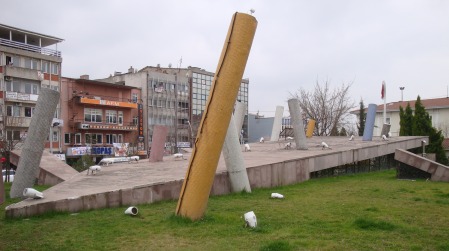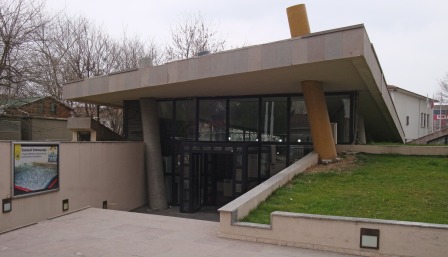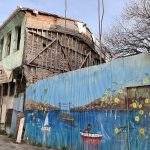I remember the heat. I remember the dust. I remember the curiously impassive faces. I remember the rumble of the giant Caterpillar trucks. I remember our minivan creeping into town in the early hours of daylight like a child late for school and fearing retribution.
Just two weeks earlier the horrific Marmara earthquake had ripped through Adapazarı at 3.02 am, killing thousands of its citizens and reducing to rubble the homes of many, many more. It was a tragedy that held all Turkey transfixed and from all over the country people rushed to help. In Göreme a group of us commandeered an empty shop and set up a collecting point for anything anyone, local or tourist, felt able to donate. Then after much bureaucratic shenaniganing we set off to deliver it, our minivan racing ahead with a heavy potato truck from Derinkuyu full of donated items bringing up the rear.
I don’t think any of us really understood what we would be facing and I remember the way the catastrophe unfolded itself in front of us slowly as if to make it easier for us. Driving towards the town centre most buildings at first looked comfortingly intact. Maybe it’s not so bad after all, was the thought, I’m sure, that we all tried out in our heads. But outside the hospital a parked refrigerated delivery truck offered one silent retort to such optimism, the pile of flimsy wooden coffins behind it another.
Still we held on to hope as we set off to reconnoitre. At a crossroads the minaret of the Güllük Cami had fallen flat across the şadırvan; a mere two hours later and it would have crushed early morning worshippers. Beyond it on a piece of land that looked like swamp a high-rise building had tilted leftwards like a plant half-pulled up by its roots, then abandoned. The white crosses on the windows suggested that it had never even been occupied before its collapse.
I remember my heart slowly sinking. I remember wondering what I was doing there. I remember an old man walking up to us, pointing down the road, saying quietly that it was worse down there, that there was nothing left in the centre. Silently, wrapped up in our own thoughts, we followed his directions, passing rows of neat middle-class apartment blocks whose owners were now conducting the private business of family life on the pavement outside: cooking dinner, boiling tea, even watching televisions rigged up to temporary power points. At the end of the street a tented camp had been set up. Children played carelessly as children do while their parents sat hopelessly and watched.
I had never been back to Adapazarı since that day, and finally returning last week I felt the same almost guilty feeling I remembered from the first visit. Would people think that I was a rubber-necker, returning belatedly to see what had happened to the town? Would I see etched on their faces the indelible scar left by the terror of that night?
I didn’t really expect to recognise anything. We had not gone there as sightseers, after all, making careful note of landmarks, and my memory stored only clips of what we’d seen, each seemingly isolated from the others. But even in the dark, peering anxiously out for a hotel, I soon spotted the Atatürk Stadium and remembered the donated goods laid out along the benches so that the Red Crescent officials could decide what to give out immediately and what to keep back for winter. As the bus turned into the wide, empty high street I spotted a familiar line-up of banks and remembered how they had looked on that day: as if a giant had hauled them up from above, then slammed them back down again causing a crazy pattern of hairline fractures to run up from their bases. And there on the left I spotted the park where the Dutch photographer, Frits Meyst, and I had slumped down on a bench at the end of the day, hot, filthy and defeated as we prepared to return to Göreme.
Today, Adapazarı is superficially insouciant about the tragedy that hit it. All the damage has been made good again, and the only things that might give an outsider pause for thought about the recent past are the huge empty spaces in the town centre. Oh, and the streets upon streets of low-rise buildings that are such an oddity in modern Turkey.
Settling into my fifth-floor hotel room I thrust aside the fleeting cowardice that tempted me to ring the receptionist and request a lower one. All was clean and modern. All was calm and reassuring. On that first visit there had been no question of worrying about food but now in the tiny lokanta where I listened to the chef explain how he made ıslama köfte (wet meatballs) memories of the earth shaking appeared to be the last things on anybody’s mind.
In the morning I went in search of a monument to the dead, expecting an obelisk perhaps, as in Karamürsel, or a plaque on the wall listing their names. Instead I came upon the Deprem Kültür Müzesi (Earthquake Culture Museum), a rather oddly named building set into a mound so that the facade looked rather like the entrance to an ancient tumulus. Above it columns studded with mosaic tiles leaned at crazy angles just as the support columns of so many badly-made buildings had done on that fateful day.
The museum was a marvellous memorial. Inside a 3D map of the city interspersed models of buildings with plastic markers for the dead. Tables and chairs were set up as they would have been in one of the quake-struck living rooms. In a showcase items worn by the rescue teams who tried for days to dig people from the rubble were on display. Most shockingly of all on show were the recordings made by the seismologists just before the quake – a lackadaisical pattern of miniature ups and downs – then the one they had made at the moment of impact – a thick black mess of condensed crescents that looked like the furious crayon scrawls of a child whose parent had upset it.
But it was the photos that did it for me. In room after room I gazed at images that brought the horror flooding back. The buildings at those terrifying angles, leaning away from each other like neighbours who couldn’t abide one another. Images of the old lost life pancaked into snapshots glimpsed through crushed windows. One house in ruins while on the balcony of the one next door a plant still sat in its pot as if nothing had happened. Someone’s beloved collie dog packed into the boot of their car. Men carrying a coffin past the shards of a building while across the road people walked up and down as if everything were normal. Boys crowding at the back of a lorry, reaching their arms up for bread. Men lined up to ring relatives and reassure them on brightly coloured plastic counter telephones. Hugs of relief between reunited friends. A statue of Atatürk standing unscathed. Concrete minarets lying in pieces. The cruel, unexpected rain that came pouring suddenly down and turned the ground beneath the refugee tents to mud.
Back in 1999 I don’t remember shedding a single tear, nor even thinking much about the dead – the needs of the living had been far too immediate and pressing. Now, though, I stood before those images and let the tears belatedly flow.


